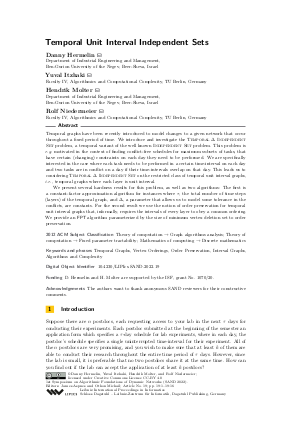@InProceedings{hermelin_et_al:LIPIcs.SAND.2022.19,
author = {Hermelin, Danny and Itzhaki, Yuval and Molter, Hendrik and Niedermeier, Rolf},
title = {{Temporal Unit Interval Independent Sets}},
booktitle = {1st Symposium on Algorithmic Foundations of Dynamic Networks (SAND 2022)},
pages = {19:1--19:16},
series = {Leibniz International Proceedings in Informatics (LIPIcs)},
ISBN = {978-3-95977-224-2},
ISSN = {1868-8969},
year = {2022},
volume = {221},
editor = {Aspnes, James and Michail, Othon},
publisher = {Schloss Dagstuhl -- Leibniz-Zentrum f{\"u}r Informatik},
address = {Dagstuhl, Germany},
URL = {https://drops.dagstuhl.de/entities/document/10.4230/LIPIcs.SAND.2022.19},
URN = {urn:nbn:de:0030-drops-159617},
doi = {10.4230/LIPIcs.SAND.2022.19},
annote = {Keywords: Temporal Graphs, Vertex Orderings, Order Preservation, Interval Graphs, Algorithms and Complexity}
}

 Creative Commons Attribution 4.0 International license
Creative Commons Attribution 4.0 International license







































